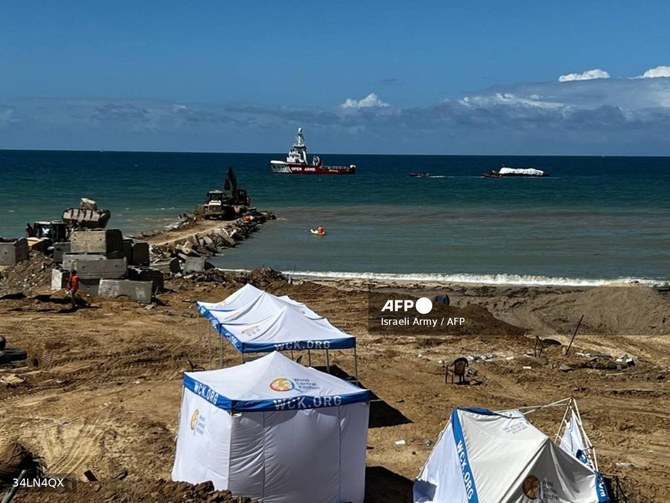Kerry Boyd Anderson
US military ships are on their way to Gaza in an effort to establish a maritime route for delivering aid. The starving and suffering Palestinians of Gaza need any aid that can be delivered, but the US effort is complicated, expensive and potentially ineffective.
On March 7, President Joe Biden announced plans for a military “emergency mission to establish a temporary pier in the Mediterranean on the Gaza coast that can receive large ships carrying food, water, medicine and temporary shelters.” He promised the US public, which is wary of engaging in any more wars in the Middle East, that no American soldiers would actually be “on the ground” in Gaza.
In technical terms, the project is expensive and complex but also impressive and feasible. About 1,000 soldiers will participate in the effort. The military will construct a floating dock where large ships can offload aid. The US will also build a floating pier that it will attach to the Gazan coast. Smaller US military vessels will then move aid packages from the dock to the pier, where trucks will pick up the aid and deliver it to land. Constructing the dock and pier and setting up the system could take up to 60 days. However, throughout the history of the Israeli-Palestinian conflict, technical feasibility is seldom the problem. Rather, politics determine outcomes and the pier plan will be no exception.
Slow, strict and convoluted Israeli inspections of aid are a major factor that has squeezed the supply via land routes. Israeli authorities do not provide clear and complete lists of prohibited items and often reject aid in ways that appear arbitrary to many aid agencies. Under the US plan, Israeli officials would inspect aid packages in Cyprus before delivery to the floating dock. However, if Israeli inspectors reject entire shipments by land because they contain scissors in medical kits for children, water filters, solar lights or tents – to name just a few of the items that Israeli inspectors have reportedly rejected – why would inspectors based in Cyprus conduct inspections any more quickly? While Israel’s reluctance to allow aid into Gaza is a huge barrier, it is not the only obstacle and the US plan faces other risks. As law and order increasingly break down in Gaza, there is no functioning authority that could guarantee the security of US military personnel and assets. While soldiers might not officially be on the ground in Gaza, they will be interacting with a war zone that includes anti-US militants, opportunistic gangs, Israeli forces that might unofficially oppose the aid deliveries and a starving population desperate for food.
It is also unclear who will actually distribute the aid and how, especially as there is no functioning infrastructure left and Israel seeks to dismantle UNRWA, the main organization with aid distribution capacity in Gaza. One of the problems with aid deliveries comes from bottlenecks related to distribution within Gaza. Humanitarian organizations trying to distribute aid have come under attack from Israeli forces and Palestinian looters. Buildings and roads are so badly damaged that trucks can struggle to get through. When aid is not delivered, it creates bottlenecks throughout the supply chain. Without basic levels of security and transportation infrastructure, aid distribution will remain limited, even if the US successfully delivers aid via a temporary pier.
Delivering aid via a temporary mechanism on Gaza’s coast is an inefficient and resource-intensive approach. Nonetheless, aid is desperately needed. After Oct. 7, Israel converted its long-standing partial siege of Gaza into a total one. Egypt opened the Rafah border crossing in late October, allowing some aid to enter. In December, Israel opened the Kerem Shalom crossing for limited amounts of aid. However, other crossing points between Gaza and Israel remain closed. A March 7 Refugees International report noted that an average of 500 trucks per day entered Gaza before the Hamas attack on Oct. 7, but now only 50 to 100 go through each day, providing far less than is needed for the population’s basic survival. Famine conditions are starting to take hold, especially in northern Gaza. A complex process of delivering aid via Cyprus and a floating dock and pier is insufficient but, amid such a crisis, something is better than nothing.
The Biden administration sincerely wants to help ease the suffering and that humanitarian impulse is partly driving the temporary pier project. Biden is also responding to diplomatic and domestic political pressures. Continuing support for Israel in the face of the devastation in Gaza is undermining US global diplomacy. The president also faces growing opposition to his approach among Democrats, which is particularly problematic in an election year. The maritime plan is a high-profile effort designed to show that Washington cares about Palestinian suffering. However, to critics within the US and abroad, the effort feels like too little, too late. Furthermore, the Biden administration appears to be twisting itself in knots to try to demonstrate humanitarian concern while refusing to use US leverage with Israel. Providing billions of dollars in weapons and other assistance should put Washington in a position to demand that Israel do more to facilitate aid deliveries. The problem is that the Israeli government knows that Biden and Congress will not withhold serious amounts of funding and therefore does not need to heed US requests. Rather, Biden is spending more US resources trying to mitigate a crisis that Washington might have the ability to end, if it had the political will to do so.







